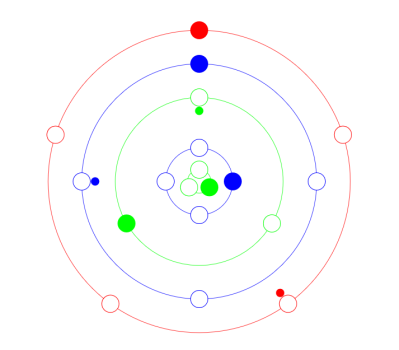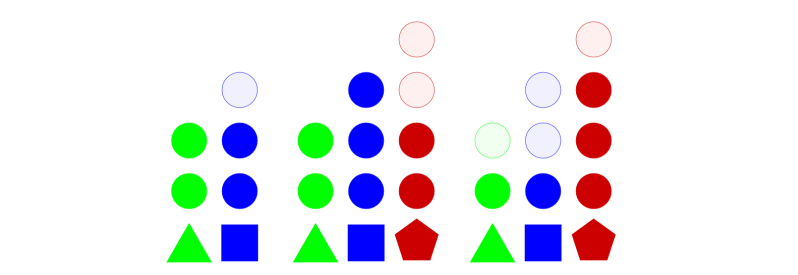Hackaday likes clocks, a lot. Speaking personally, from my desk I can count at least eight clocks, of which seven are working. There’s normal quartz movement analog clocks, fun automatic wristwatches, run-of-the-mill digital clocks, a calculator watch, and a very special and very broken Darth Vader digital clock/radio combo that will get fixed one day — most likely. Every clock is great, and one of life’s great struggles is to see how many you can amass before you die. The more unique the clock is, the better, and nothing (so far) tops [Antonella Perucca]’s Chinese Remainder Clock.

What separates [Antonella Perucca]’s clock from the rest lies in the Chinese Remainder Theorem, an eighteen hundred year old idea from Chinese mathematician Sunzi. Basically, when applied to the positive integers, the Chinese Remainder Theorem states that the set of integers modulo some positive integer N is equivalent (isomorphic as rings) to the product of the sets of integers modulo factors of N such that these factors are all relatively prime to each other and their product is N.
It sounds a mouthful, but it actually makes a lot of intuitive sense. Take for example N = 6. The set of integers modulo 6 is S = {0, 1, 2, 3, 4, 5}. 2 and 3 are relatively prime to each other and their product is 6. The set of integers modulo 2 and 3 are {0, 1} and {0, 1, 2} respectively. If you form the product of these two sets, you get the set T = {(0,0), (1,0), (0,1), (1,1), (0,2), (1,2)}. If you take any element x from S and send it to the element (x mod 2, x mod 3) in T, you quickly see how the two sets can be considered equivalent. Each element in S is sent to one and only one element in T, and both sets have the same number of elements. Taking N to be 6 may seem like an easy number to work with, but the beauty of the Chinese Remainder Theorem shows this same concept holds for any positive integer.
Now how does this apply to clocks? Well, two relatively prime factors of 12 are 3 and 4. Three relatively prime factors of 60 are 3, 4, and 5. We’re doing clock arithmetic modulo 12 and 60 anyway. Thus we can directly apply our the orem. Each hour can be represented uniquely by its remainder modulo 3 and 4. Each minute and second show up as their remainders modulo 3, 4, and 5. In the diagram above, imagine each circle starts at 0 and goes up clockwise by 1 for each bubble. The hours are the inside circles, the minutes are the outside circles, and the seconds are the tiny bubbles following the minutes. A clock starts to emerge then. Of course, you don’t have to stick with the somewhat familiar circular clock-face. You can use the same concept digitally, as in the image the very top of the article. Or you can go even further off the beaten track and rely completely on shaded polygons for that true abstract feel.
orem. Each hour can be represented uniquely by its remainder modulo 3 and 4. Each minute and second show up as their remainders modulo 3, 4, and 5. In the diagram above, imagine each circle starts at 0 and goes up clockwise by 1 for each bubble. The hours are the inside circles, the minutes are the outside circles, and the seconds are the tiny bubbles following the minutes. A clock starts to emerge then. Of course, you don’t have to stick with the somewhat familiar circular clock-face. You can use the same concept digitally, as in the image the very top of the article. Or you can go even further off the beaten track and rely completely on shaded polygons for that true abstract feel.
[Antonella Perucca] introduced the idea in “The College Mathematics Journal” less than a year ago, so it hasn’t seen too much use yet. However, anything that’s been done with regular clocks can be done with this one, and by sharing its existence, hopefully we get some really intriguing projects. It can even be in binary, for old time’s sake.
















Nothing you’ve written makes intuitive sense. Wow that’s a lot of technobable.
I think i’d rather have a clock that demarcates the time by delivering a quick succession of kicks to my testicles to count up the day in fifteen-minute intervals. Don’t kink-shame me.
Electrical kicks or just regular ones? btw, YKINMKBYKIOK
I can imagine explaining that to one of my wife’s air-headded friends..
What’s the point of putting all that effort to come up with a clock that is magnitudes more difficult to read?
ahhh… “the point” discussion again.
First of all these kind of projects have no point other than it is fun to do. And that you always learn something from it.
The expected effects when having these kind of clocks in your home is that they (visitors to your home) think you are a nerd (as in stupid) or they think you are a nerd (as in smart (because you can read this complex clock) AND stupid (because they can’t)). Personally I’m more of a fan of a traditional kind of clock, one with an indicator. Now how that indicator points, doesn’t matter, but seeing the indicator move is a very intuitive way of telling that time is passing. So when you look at it and then a few minutes later look at it again and see that the indicator has moved a few cm… that’s intuitive. Having multiple lights light up in a different order takes much more practice and is therefore less intuitive. (Intuitive: Using or based on what one feels to be true even without conscious reasoning. Instinctive)
“Having multiple lights light up in a different order takes much more practice” – with one exception: When this multiple lights form nice 7 segment numbers. I consider that (digital watch/clock) much more intuitive to read instead of angles of clock hands.
if You need one-minute resolution, then yes. Look at how you use time and you will notice that 5-minute or even 15-minute is just enough – we have a feeling of time embedded and actually reading numbers requires a little of processing power to convert pure number to this feeling scale
Usually when I see a picture of a clock and the time it’s displaying is written underneath I can work out how that particular display works, but not with this one, not even having read the article twice. My preference is for a circle of numbers, ideally 12 but 4 would do if they’re spaced evenly, and a couple of sticks that point to the relevant numbers, not only does it tell the time but it shows you how much time remains in the current hour instantly with no math whatsoever,as an additional bonus the little ones can be carried around and used as a compass if the sun is up.
Except from the compass use a digital watch is better, telling the time in nice numbers which are imediately redable instead of having to make out angles.
BtW: Mine has a compass sensor which works also when the sun is not visible, although it likes the occasional sunlight to keep it’s battery powered.
Nice! Very instructive. Really looking forward for the (discrete) mechanical (wrist) version of it. For example using gear ratios that are rel. prime, with the carry over to minute/hour being some mechanical kind of AND. A nice webpage she has, too. Patenting this, however, is a bit sad IMHO.
Chinese Remainder Theorem was thought in my CS course. Is this not the norm? I also think systems working on primes, shapes and remainders are far more intuitive. The reason you guys are so against this, is because you’ve been taught the traditional method of reading a clock. Food for thought: https://www.youtube.com/watch?v=hP-DZMmQBng
I think you got it wrong. The number system, whether decimal or otherwise, was invented to solve a problem, ie to facilitate counting, communicating, etc. What the boy demonstrated, it is not even creative, was what people endured and suffered pre-number system days. It is not new or original, and certainly not intuitive. It is extremely cumbersome and totally unscalable. Because of its impracticality, it was abandoned more than 3,000 years ago.
Because someone made a YouTube video, it doesn’t mean that it is the authority or something is the truth or right.
Unless I’m reading it wrong (high probability) I think your “cr clock” picture with the polygons is off: H(2,2), M(0,2,4), S(0,3,1) = 2:54:51 not 2:54:50
Yes, I think you are indeed right, nice catch! There is a comment in the sources that might be related:
https://github.com/johnperry-math/Chinese-Remainder-Clock/blob/master/TODO.txt (first few lines)
On my phone, there is a noticeable, sub-second slack between the two representations (remainders are slightly faster). I guess the screenshot is taken with unfortunate timing.
Great app though! Would be awesome to have it on the always-on display!